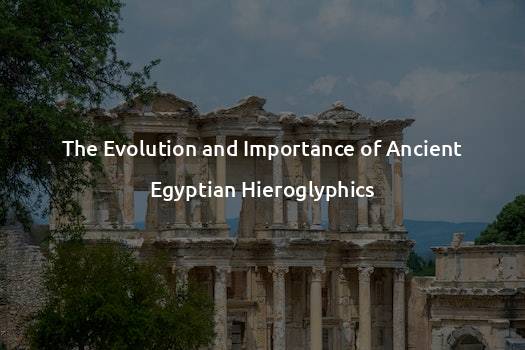The Evolution and Importance of Ancient Egyptian Hieroglyphics
The Evolution and Importance of Ancient Egyptian Hieroglyphics
Ancient Egypt, a civilization that flourished along the banks of the Nile River from around 3100 BCE to 30 BCE, left behind a captivating legacy. From stunning architecture to majestic pharaohs, the ancient Egyptians were known for their rich culture and intriguing beliefs. Among their many accomplishments, one of the most fascinating is the development and use of hieroglyphic writing. Hieroglyphics were an integral part of Egyptian society, serving as a means of communication, record-keeping, and artistic expression. In this article, we explore the evolution and importance of ancient Egyptian hieroglyphics.
The Birth of Hieroglyphics
The origins of hieroglyphics can be traced back to around 3300 BCE during the late Predynastic Period. At this time, early Egyptians used simple pictorial symbols to communicate and depict their thoughts and experiences. These symbols were often carved or painted onto pottery, and over time, the complexity and variety of symbols increased.
By the Early Dynastic Period (around 3100 BCE), hieroglyphic writing had evolved into a more sophisticated system incorporating both ideograms (symbols representing ideas) and phonograms (symbols representing sounds). Hieroglyphics allowed the ancient Egyptians to convey a broad range of objects, actions, and abstract concepts through a combination of symbols.
The Role of Hieroglyphics in Ancient Egypt
Hieroglyphics held great significance in numerous aspects of ancient Egyptian society. In addition to being used for communication, hieroglyphs played a role in religious rituals, governmental administration, and royal propaganda.
1. Communication: Hieroglyphics served as a primary mode of written communication among both the literate elite and the general population. Although only a small percentage of ancient Egyptians were literate, the ability to read and write hieroglyphics was highly valued. Hieroglyphic inscriptions were commonly found in tombs, temples, and public monuments, ensuring that the written word was accessible to all.
2. Religious Significance: The ancient Egyptians had a strong belief in the afterlife, and hieroglyphics played a crucial role in religious rituals and funerary practices. Sacred texts, such as the Book of the Dead, were written in hieroglyphics to guide and protect the deceased in their journey to the afterlife. Temples were adorned with hieroglyphic inscriptions honoring deities and retelling myths and legends.
3. Government and Administration: Hieroglyphics were instrumental in the functioning of the Egyptian bureaucracy. Scribes, who were highly respected individuals, used hieroglyphics for record-keeping, documenting legal transactions, and preparing official correspondence. The decipherment of hieroglyphics by modern scholars has provided valuable insights into the intricate administrative systems of ancient Egypt.
4. Royal Propaganda: Pharaohs used hieroglyphics to promote their authority and record their achievements. Inscriptions on temple walls and royal monuments glorified the pharaoh’s reign, depicting triumphant battles, architectural accomplishments, and divine connections. Hieroglyphics were an essential tool for legitimizing and immortalizing the pharaoh’s rule.
The Decipherment of Hieroglyphics
For centuries, the meaning of hieroglyphics remained a mystery to the world. It was not until the early 19th century, with the discovery of the Rosetta Stone, that progress was made in deciphering this ancient writing system.
The Rosetta Stone, found in 1799, contained a decree issued by King Ptolemy V in 196 BCE. This decree was written in three scripts: hieroglyphics, demotic (a cursive script used for daily communication), and ancient Greek. The Greek text provided the key to unlocking the hieroglyphic code.
Linguist Jean-François Champollion played a pivotal role in deciphering hieroglyphics. By comparing the Greek text on the Rosetta Stone with the hieroglyphic inscriptions, he identified recurring patterns and phonetic elements, ultimately unraveling the complex system of hieroglyphics.
The Legacy and Importance of Hieroglyphics Today
The decipherment of hieroglyphics opened the doors to understanding the rich history and culture of ancient Egypt. This monumental discovery allowed scholars to read and analyze documents and inscriptions spanning thousands of years.
Hieroglyphics continue to fascinate people worldwide, captivating their imaginations with the intricate beauty of these ancient symbols. They have become a powerful emblem of ancient Egyptian civilization and a subject of interest in academia and popular culture.
Today, hieroglyphics are predominantly studied by Egyptologists, linguists, and historians, shedding light on various aspects of ancient Egypt, including literature, religion, and daily life. The study of hieroglyphics has brought us closer to the ancient Egyptians and their way of thinking, enabling us to appreciate their achievements and legacy.
TLDR;
Ancient Egyptian hieroglyphics evolved from simple pictorial symbols to a sophisticated writing system during the Predynastic and Early Dynastic Periods. These symbols played a vital role in ancient Egypt, serving as a means of communication, religious expression, bureaucratic administration, and royal propaganda. The decipherment of hieroglyphics in the 19th century, thanks to the Rosetta Stone and Jean-François Champollion, revealed a wealth of knowledge about ancient Egyptian civilization. Today, the study of hieroglyphics continues to provide insights into the rich history, culture, and beliefs of one of the world’s most intriguing civilizations.







